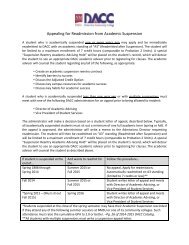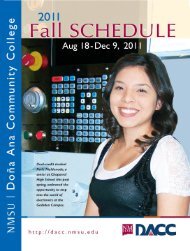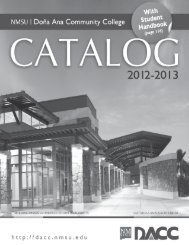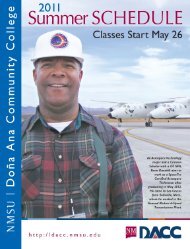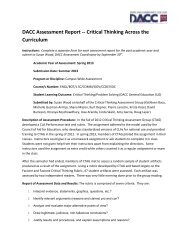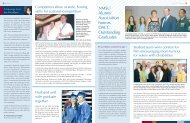online - Dona Ana Community College - New Mexico State University
online - Dona Ana Community College - New Mexico State University
online - Dona Ana Community College - New Mexico State University
Create successful ePaper yourself
Turn your PDF publications into a flip-book with our unique Google optimized e-Paper software.
<strong>New</strong> <strong>Mexico</strong><br />
Common Course Numbers<br />
The course prefix and number that appear in parenthesis next to the<br />
NMSU course number (in the previous section) is the <strong>New</strong> <strong>Mexico</strong><br />
Common Course Number. The common course number connects<br />
equivalent courses at multiple institutions ensuring students that the<br />
course will transfer to the receiving institution and meet degree requirements<br />
as if it were taken on that campus.<br />
Transferring Courses<br />
Within Degree Programs<br />
To facilitate the transfer of courses within certain degree programs,<br />
<strong>New</strong> <strong>Mexico</strong> colleges and universities have collaborated to develop<br />
transferable discipline modules. These are made up of an agreedupon<br />
number of hours and courses. When discipline module courses<br />
are taken in addition to the 35-hour general education core, the<br />
total number of hours in a transfer module are approximately 64.<br />
Transferring to Related<br />
Programs at Other Institutions<br />
Transfer agreements for specific programs exist between Doña<br />
<strong>Ana</strong> <strong>Community</strong> <strong>College</strong> and selected four-year institutions, most<br />
of which are in <strong>New</strong> <strong>Mexico</strong>. For further information, refer to the<br />
Transfer and Transition Guides posted on the Web at http://dabsys.<br />
nmsu.edu/dabcctransguides/<br />
NOTE: Students transferring to another institution should consult<br />
that institution’s catalog for the most current information.<br />
Student Responsibility<br />
<strong>New</strong> <strong>Mexico</strong>’s colleges and universities have collaborated to produce<br />
guides to assist students who plan to transfer before completing<br />
a program of study. Course modules are designed to help students<br />
select courses carefully so that they may transfer with little or no loss<br />
of credit. However, planning for effective transfer within maximum<br />
efficiency is ultimately the student’s responsibility. Responsible<br />
transfer planning includes early and regular consultation with the<br />
intended degree-granting institution to assure that all pre-transfer<br />
course work will meet the requirement of the of desired degree.<br />
Complaint Procedure<br />
for Transfer Credit Appeal<br />
All <strong>New</strong> <strong>Mexico</strong> public post-secondary institutions are required to<br />
establish policies and practices for receiving and resolving complaints<br />
from students or from other complainants regarding the<br />
transfer of course work from other public institutions in the state. A<br />
copy of NMSU’s complaint policy may be obtained from the Office<br />
of the Registrar or from the Deputy Secretary for Academic Affairs,<br />
Higher Education Department, <strong>New</strong> <strong>Mexico</strong> School for the Deaf<br />
Campus, 1068 Cerrillos Road, Santa Fe, <strong>New</strong> <strong>Mexico</strong> 87505-1650.<br />
Applying DACC Degrees and Credit<br />
Toward Bachelor’s Degree Programs<br />
Many DACC courses may apply toward bachelor’s degree<br />
programs at NMSU and other universities. When planning to<br />
transfer, it is best to consult with advisers at both DACC and the<br />
university you have chosen.<br />
The following nine programs offered through DACC articulate with<br />
bachelor’s degree programs at either <strong>New</strong> <strong>Mexico</strong> <strong>State</strong> <strong>University</strong><br />
or the <strong>University</strong> of <strong>New</strong> <strong>Mexico</strong>, as indicated:<br />
• Associate of Arts Degree to all departments in the NMSU <strong>College</strong><br />
of Arts and Sciences<br />
• Associate of Science Degree to all departments in the NMSU<br />
<strong>College</strong> of Arts and Sciences<br />
• Creative Media Technology to the NMSU <strong>College</strong> of Arts and<br />
Sciences<br />
• Criminal Justice to the Department of Criminal Justice in the<br />
NMSU <strong>College</strong> of Arts and Sciences<br />
• Early Childhood Education and Education programs to the<br />
NMSU <strong>College</strong> of Education<br />
• Pre-Architecture Option of the Drafting and Design Technologies<br />
Program to the UNM School of Architecture and<br />
Planning<br />
• Pre-Business to all departments in the NMSU <strong>College</strong> of Business<br />
• Public Health to the Department of Health Science, NMSU<br />
<strong>College</strong> of Health and Social Services<br />
• Computer- and technology-related associate degree programs<br />
to the NMSU Information and Communication Technology<br />
bachelor’s degree program in the Engineering Technology Department,<br />
<strong>College</strong> of Engineering<br />
In addition to the specific programs listed above, any associate of<br />
applied science degree earned at DACC may be applied in its entirety<br />
toward the Bachelor of Applied Studies or Bachelor of Individualized<br />
Studies degree offered by NMSU’s <strong>College</strong> of Extended<br />
Learning.<br />
A majority of the credits earned in the following associate degree<br />
programs at DACC will apply toward meeting bachelor’s degree requirements<br />
of specified departments at NMSU:<br />
• Business Occupations to the Department of Agricultural Economics<br />
and Agricultural Business in the <strong>College</strong> of Agriculture<br />
and Home Economics<br />
• Business Office Technology to the Department of Curriculum<br />
and Instruction, <strong>College</strong> of Education<br />
• Electronics Technology to the Department of Engineering Technology<br />
in the NMSU <strong>College</strong> of Engineering<br />
• Emergency Medical Services, Radiologic Technology, and Respiratory<br />
Care to the Department of Health Science, <strong>College</strong> of<br />
Health and Social Services<br />
• Hospitality Services to the Hospitality, Restaurant, and Tourism<br />
Management Department, <strong>College</strong> of Agriculture and Home<br />
Economics<br />
• Nursing to the Department of Nursing, <strong>College</strong> of Health and<br />
Social Services<br />
Those planning to teach at the secondary level may apply at least 36<br />
credits earned in the following DACC programs toward the bachelor<br />
of science degree in Agricultural and Extension Education (<strong>College</strong><br />
of Agriculture and Home Economics): Automation and Manufacturing<br />
Technology; Automotive Technology; Computer Technology;<br />
Digital Graphics Technology; Drafting and Design Technology; Electrical<br />
Apprenticeship; Electronics Technology; Heating, Ventilation,<br />
Air Conditioning and Refrigeration; Water Technology; and Welding<br />
Technology.<br />
2 0 0 7 - 2 0 0 8 C A TA L O G<br />
25



